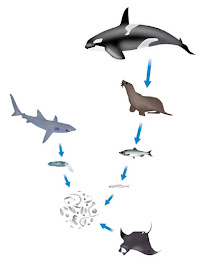A graphic organizer is an instructional tool used to illustrate a student or class's prior knowledge about a topic or section of text; specific examples include the
K-W-L-H Technique and the
Anticipation/Reaction Guide. Other organizers include the:
Spider Map

Used to describe a central idea: a thing (a geographic region), process (meiosis), concept (altruism), or proposition with support (experimental drugs should be available to AIDS victims). Key frame questions: What is the central idea? What are its attributes? What are its functions?
Series of Events Chain

Used to describe the stages of something (the life cycle of a primate); the steps in a linear procedure (how to neutralize an acid); a sequence of events (how feudalism led to the formation of nation states); or the goals, actions, and outcomes of a historical figure or character in a novel (the rise and fall of Napoleon). Key frame questions: What is the object, procedure, or initiating event? What are the stages or steps? How do they lead to one another? What is the final outcome?
Continuum Scale

Used for time lines showing historical events or ages (grade levels in school), degrees of something (weight), shades of meaning (Likert scales), or ratings scales (achievement in school). Key frame questions: What is being scaled? What are the end points?
Compare/Contrast MatrixUsed to show similarities and differences between two things (people, places, events, ideas, etc.). Key frame question: What things are being compared? How are they similar? How are they different?
Problem/Solution Outline

Used to represent a problem, attempted solutions, and results (the national debt). Key frame questions: What was the problem? Who had the problem? Why was it a problem? What attempts were made to solve the problem? Did those attempts succeed?
Network Tree

Used to show causal information (causes of poverty), a hierarchy (types of insects), or branching procedures (the circulatory system). Key frame questions: What is the superordinate category? What are the subordinate categories? How are they related? How many levels are there?
Human Interaction Outline

Used to show the nature of an interaction between persons or groups (Europeans settlers and American Indians). Key frame questions: Who are the persons or groups? What were their goals? Did they conflict or cooperate? What was the outcome for each person or group?
Fish bone Map

Used to show the causal interaction of a complex event (an election, a nuclear explosion) or complex phenomenon (juvenile delinquency, learning disabilities). Key frame questions: What are the factors that cause X ? How do they interrelate? Are the factors that cause X the same as those that cause X to persist?
Cycle

Used to show how a series of events interact to produce a set of results again and again (weather phenomena, cycles of achievement and failure, the life cycle). Key frame questions: What are the critical events in the cycle? How are they related? In what ways are they self-reinforcing?
 In broad terms, user-centered design (UCD) is a design philosophy and a process in which the needs, wants, and limitations of the end user of an interface or document are given extensive attention at each stage of the design process. User-centered design can be characterized as a multi-stage problem solving process that not only requires designers to analyze and foresee how users are likely to use an interface, but also to test the validity of their assumptions with regards to user behaviour in real world tests with actual users. Such testing is necessary as it is often very difficult for the designers of an interface to understand intuitively what a first-time user of their design experiences, and what each user's learning curve may look like.
In broad terms, user-centered design (UCD) is a design philosophy and a process in which the needs, wants, and limitations of the end user of an interface or document are given extensive attention at each stage of the design process. User-centered design can be characterized as a multi-stage problem solving process that not only requires designers to analyze and foresee how users are likely to use an interface, but also to test the validity of their assumptions with regards to user behaviour in real world tests with actual users. Such testing is necessary as it is often very difficult for the designers of an interface to understand intuitively what a first-time user of their design experiences, and what each user's learning curve may look like.










